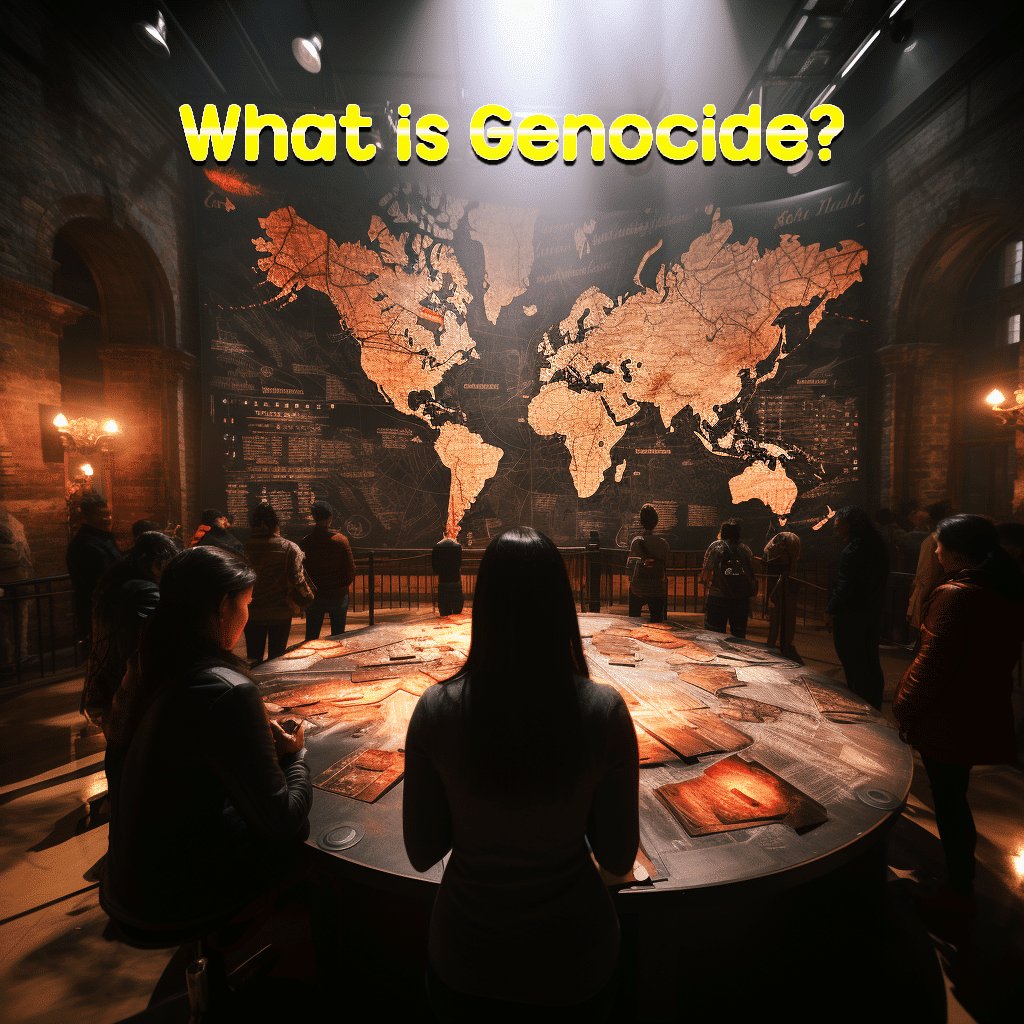What is Genocide? Book Summary

In “What is Genocide?” by Martin Shaw, we find a unique endeavor to delve into the intricate complexities of a crime that humanity has witnessed throughout history. This book is not just a historical or legal study but is a reflection on the human spirit and the conditions that might lead an entire society to partake in a heinous act like genocide.
Shaw aims to provide a comprehensive definition of genocide, starting from the historical origins of the word to its application in international law. But he doesn’t stop there; he takes the reader on a journey through time, presenting vivid examples of genocides that have occurred in various parts of the world.
Through “What is Genocide?”, we learn about the circumstances that contributed to the occurrence of these crimes, as well as the factors that might prevent their occurrence in the future. It’s a book that calls for awareness and reflection, essential for anyone wishing to understand our human history and how to shape a more humane future.
What is the True Origin and Definition of Genocide?
Diving into “What is Genocide?” by Martin Shaw provides readers with an enriched understanding of the profound gravity behind the term ‘genocide.’ In a world that often loosely uses terms without fully grasping their weight, Shaw ensures that we come face-to-face with the stark reality and significance of this particular term.
When delving into the definition and etymology section of the book, it becomes evident that the term ‘genocide’ isn’t just a combination of words or a fleeting concept. Rather, it embodies a somber history of human actions, tragedies, and the systemic elimination of entire communities based on their identity. Originating from the Greek word ‘genos,’ meaning race or tribe, and the Latin suffix ‘cide,’ meaning killing, ‘genocide’ brutally signifies the intentional extermination of an ethnic, racial, or religious group.
But how did this term find its place in our modern lexicon? Raphael Lemkin, influenced by the horrors of the Holocaust during World War II, first coined the term. Recognizing a void in the international legal system that lacked a term to describe such heinous acts of group-targeted violence, Lemkin sought to ensure that there was a word potent enough to encapsulate the depth of such atrocities. His persistence paved the way for the term’s adoption in international treaties and conventions, notably in the Genocide Convention of 1948.
Understanding the origins and precise definition of ‘genocide’ is more than an academic pursuit. It’s a reminder of our shared responsibility to recognize and confront acts that threaten the very fabric of our shared humanity. Through Shaw’s meticulous exploration, readers are encouraged not just to know the word, but to understand its gravity and the dire consequences it represents.
How Does the Genocide Convention of 1948 Define Genocide in International Law? from What is Genocide
In the encompassing narrative of “What is Genocide?” Martin Shaw offers a meticulous exploration of the profound implications surrounding the term ‘genocide.’ One of the standout sections in the book provides an in-depth analysis of the legal framework underpinning the understanding and classification of genocide in international contexts.
The Genocide Convention of 1948 serves as a foundational pillar in this discourse. Post the horrors of World War II and the chilling events of the Holocaust, there arose an imperative need to crystallize a legal definition that would ensure such atrocities were not only acknowledged but actively prevented in the future. The Genocide Convention was an international response, aiming to codify what constitutes genocide and establish accountability mechanisms.
Shaw explicates that the Convention doesn’t merely present a dry, legalistic definition. Instead, it outlines genocide as acts committed with the intent to destroy, in whole or in part, a national, ethnical, racial, or religious group. This includes causing serious bodily or mental harm to members of the group, deliberately inflicting conditions leading to its physical destruction, imposing measures to prevent births within the group, and forcibly transferring children of the group to another group.
The significance of this Convention in international law cannot be understated. Not only did it pave the way for global acknowledgment of past genocides, but it also established a legal foundation upon which nations could be held accountable for future potential genocidal acts.
In essence, Shaw’s exploration in “What is Genocide?” of the Genocide Convention provides readers with a comprehensive understanding of how the international community has striven to legally define, and subsequently prevent, one of the gravest crimes against humanity: genocide.
History – Book Summary (khkitab.com)
How Does ‘What is Genocide?’ Differentiate Between Genocide and Other Forms of Mass Violence?
Delving into Martin Shaw’s “What is Genocide?” unveils a profound exploration of various patterns of mass violence, highlighting the intricacies and distinctions between them. One of the pivotal discussions in the book focuses on the differentiation of genocide from other types of mass atrocities.
Genocide, as emphasized by Shaw, possesses a unique characteristic: the intent to obliterate an ethnic, racial, religious, or national group, either wholly or partially. This distinguishing intent sets genocide apart from other mass violence manifestations. While the loss of life might be a common thread, the underlying motivations and targets diverge significantly.
For instance, politicides, another form of mass violence discussed by Shaw, primarily target political groups. The intention behind politicides usually stems from the desire to maintain power or eliminate political opposition, rather than the extermination of a particular ethnic or racial group. On the other hand, classicide, a term less commonly used but equally significant, pertains to large-scale violence targeting social classes, driven by socio-economic motivations.
By comparing and contrasting these various forms of violence, Shaw offers readers not just definitions but a broader understanding of the societal, political, and ideological factors leading to such events. It is this intricate analysis that underscores the uniqueness of each form of mass violence and emphasizes the significance of recognizing these differences. Such recognition is paramount, for only by understanding these distinctions can society effectively address and work towards preventing such heinous acts in the future.
How Does ‘What is Genocide?’ Illuminate Key Historical Genocides Through Detailed Case Studies?
In the illuminating “What is Genocide?” by Martin Shaw, readers are taken on an enlightening journey through time, traversing dark chapters of humanity’s history. A core segment of this book delves deep into historical case studies, offering an insightful examination of major genocides, thus shedding light on the brutal episodes that have shaped the very understanding of this heinous act.
The Holocaust stands out as a prime example. As Shaw navigates through its horrors, he paints a harrowing picture of the systemic extermination of six million Jews by the Nazi regime. This tragedy, rooted in virulent anti-Semitism and state-sponsored hate, epitomizes the very essence of genocide, providing a clear manifestation of the intent to obliterate an entire community based on their ethnic or religious identity.
Yet, the Holocaust isn’t the sole focus. The Armenian Genocide, often termed the ‘forgotten genocide,’ is also brought to the fore. Shaw’s portrayal of the systematic massacre of 1.5 million Armenians by the Ottoman Empire during World War I underscores the political and cultural motivations behind genocidal acts. This event emphasizes the devastating consequences when international communities turn a blind eye to mass atrocities, considering the long denial it faced.
The Rwandan Genocide, a more recent dark chapter, is another pivotal case study. Here, Shaw captures the swift and brutal slaughter of nearly 800,000 Tutsis and moderate Hutus within a mere span of 100 days. This genocide, driven by deeply rooted ethnic tensions and political manipulations, serves as a chilling reminder of how quickly humanity can spiral into chaos when divisive ideologies take hold.
By meticulously examining these historical genocides, “What is Genocide?” achieves more than just recounting past events. It offers a poignant commentary on the cyclical nature of such atrocities, the conditions that breed them, and the importance of global awareness and intervention. It’s a clarion call for understanding, reflection, and collective action to ensure history’s darkest chapters are not repeated.
Our Facebook Page – Book Summary
What Sociopolitical Dynamics in ‘What is Genocide?’ Illuminate the Precursors to Genocidal Events?
Martin Shaw’s “What is Genocide?” stands as a beacon of deep analysis into the treacherous territories of genocidal occurrences. One of the most enlightening sections of this tome probes into the sociopolitical factors that culminate in such catastrophic events. This segment unravels the intricate web of conditions and triggers, highlighting the gradual progression towards mass violence.
Extremist ideologies take center stage in the discourse. Shaw emphasizes how radical beliefs, when allowed to permeate societal fabric, can build a foundation for genocidal acts. Such ideologies often stem from distorted views of superiority, racial or ethnic purity, or even divine mandates. When these beliefs are ingrained deeply within a population, it creates a breeding ground for discrimination, intolerance, and eventual violence.
Dehumanization processes are another pivotal aspect discussed by Shaw. He expounds on how potential victims are frequently depicted as ‘other,’ ‘lesser,’ or even ‘inhuman’ by the perpetrating groups. Such categorizations are not merely rhetorical; they lay the groundwork for justifying violence, as stripping away the humanity of a group makes it easier for the masses to accept, or even participate in, their persecution. This process is a psychological tool that facilitates the justification and rationalization of heinous acts against the targeted group.
Moreover, the intricacies of political machinations and their role in fueling genocides are meticulously dissected. Shaw delves into how certain political agendas or power struggles can exploit and exacerbate existing societal rifts, converting them into full-blown genocidal campaigns.
By unearthing these sociopolitical dynamics, “What is Genocide?” not only offers an academic analysis but also a stark warning. It underlines the importance of vigilance, education, and active prevention to thwart the seeds of genocide from taking root. The book calls for a collective responsibility to recognize and counteract these dynamics, ensuring that society remains guarded against its darkest potentials.
Why Does the International Community Struggle in Responding Effectively to ‘Genocides? From ‘What is Genocide
The intricate narrative of “What is Genocide?” by Martin Shaw delves deep into the complexities surrounding the international community’s reaction to genocides. This dimension of the book unveils the labyrinth of challenges and political intricacies that often delay or undermine the global response to such severe crises.
One fundamental issue that Shaw highlights is the problem of recognition. Before any concrete action can be taken, there’s the challenge of universally acknowledging that a genocide is, indeed, taking place. This process isn’t straightforward. The very definition of ‘genocide’ is often debated and dissected by scholars, politicians, and legal experts, leading to delays and disagreements on the ground.
Political interests also play a significant role in this hesitancy. Shaw discusses how geopolitical alliances, economic partnerships, and strategic interests can influence a nation’s or group of nations’ willingness to intervene or even acknowledge a genocide. In some cases, powerful nations may choose to overlook or downplay genocidal events if acknowledging them would jeopardize their strategic or economic interests.
Moreover, the shadow of past interventions haunts the international community. Prior endeavors, even if carried out with the best of intentions, might have led to unintended consequences, creating a sense of caution and, at times, reluctance to intervene again.
Logistics and feasibility are another set of challenges. Even when there’s a consensus about the necessity of intervention, the logistics concerning how, when, and with what resources can be daunting. Without a clear strategy and commitment, such interventions might lead to more harm than good.
By analyzing these multifaceted challenges, “What is Genocide?” offers an insightful look into the difficulties of mounting an effective international response. Shaw’s work underscores the importance of a unified, timely, and decisive action when confronting genocides, urging the global community to prioritize humanity above political or economic considerations.
How Does ‘What is Genocide?’ Advocate for Prevention and Post-Genocide Justice?’
In “What is Genocide?” by Martin Shaw, a significant emphasis is placed on the imperatives of prevention and the quest for justice following genocidal events. This pivotal section of the book serves as both a call to action and a comprehensive guide on the mechanisms available to the global community to halt genocidal tendencies and ensure perpetrators face their due retribution.
One of the primary topics Shaw delves into is the need for early intervention. Recognizing the warning signs of an impending genocide, such as increasing hate speech, systematic discrimination, and escalating violence against a particular group, is crucial. Early detection and action can significantly mitigate potential atrocities, saving countless lives in the process. Shaw underscores the importance of continuous monitoring, international collaboration, and proactive diplomacy to preclude the advancement of genocidal agendas.
International cooperation stands as another pillar in Shaw’s discourse. No single nation, regardless of its prowess, can single-handedly prevent a genocide or bring its instigators to justice. Collaborative efforts, be it through the United Nations, regional organizations, or coalitions of like-minded states, enhance the effectiveness and reach of preventive actions. Sharing intelligence, coordinating diplomatic pressures, and joint military interventions, when necessary, can create a formidable barrier against those aiming to wipe out an entire populace.
Lastly, the pursuit of justice post-genocide is fervently championed. Shaw underscores the significance of holding perpetrators accountable, not just as a form of retribution, but as a deterrent for future potential genocidaires. Establishing and supporting international courts, such as the International Criminal Court, ensures that those responsible for orchestrating and executing genocides face consequences for their heinous actions.
Through an intricate examination of prevention mechanisms and post-genocide justice endeavors, “What is Genocide?” calls upon readers and leaders alike to remain vigilant, unified, and unyielding in the face of one of humanity’s gravest crimes. The book embodies the belief that with concerted effort, the world can indeed ensure that “Never Again” is not just a phrase, but a reality.
Can Understanding Past Genocides Offer a Blueprint for Future Prevention? From ‘What is Genocide?’
Within the pages of “What is Genocide?” by Martin Shaw, readers are prompted to deeply reflect upon the recurrent patterns that have marked past genocides. This introspective section offers more than a historical recounting; it is a clarion call for humanity to glean lessons from past tragedies to preempt future occurrences.
Shaw meticulously analyzes the common threads that have woven through previous genocidal events. These shared characteristics often include the dehumanization of targeted groups, the buildup of extremist ideologies, the utilization of propaganda to instigate hate, and the systematic dismantling of political and societal checks and balances that might otherwise inhibit such extreme actions.
The importance of recognizing these patterns cannot be understated. By understanding these precursors and their typical sequence, governments, international organizations, and civil society can potentially identify the warning signs of an impending genocide. Recognizing these early indicators is the first, crucial step toward preventive action.
Moreover, Shaw emphasizes the role of education and collective memory. By ensuring that the horrors of past genocides are widely taught and never forgotten, societies can fortify themselves against the insidious ideologies that underpin such atrocities. Educating the younger generation about these grim chapters of history can create a more informed, vigilant, and compassionate populace that actively resists divisive and hateful narratives.
In addition, international collaborations and alliances can play a pivotal role. By establishing a shared commitment to preventing genocides and setting up mechanisms that allow for swift and coordinated responses, the international community can ensure that when warning signs do appear, they are met with rapid and decisive action.
Shaw’s “What is Genocide?” pushes readers to confront an uncomfortable truth: that the seeds of genocide often germinate in seemingly ordinary conditions, cultivated by societal indifference and political opportunism. But by understanding these patterns and acting upon the lessons of history, there is hope that future generations can be spared the horrors of mass extermination.


